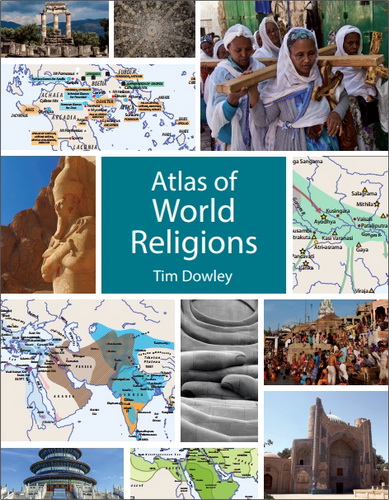
Dowley - Atlas of World Religions

Mesopotamia is the Greek name for the lands of the Tigris and Euphrates rivers, currently occupied by Iraq and Syria. This region had no easily defensible frontiers, and throughout historical times fierce hill-people raided from the east, while herdsmen from the steppe overran the fertile lands from the west and south, as they saw the potential of cultivating its rich soil and fishing its rivers. The northern part of Mesopotamia has enough annual rainfall for farmers to grow grain and find pasture, and people have lived in its hills and near its rivers since Neolithic times, about 12,000 years ago.
In ancient Babylonia to the south, agriculture depended on artificial irrigation, drawing water from the rivers and carefully controlling it. This skill was apparently introduced there around 5000 bce, after which settled life developed until the fourth millennium bce, when great cities flourished by the rivers and canals. From these cities, traders and colonists spread north up the Euphrates river into Syria, east into Persia, and south down the Persian Gulf, carrying inventions and ideas from their culture -foremost among them writing. The need to organize and administer the large settlements and their irrigation systems stimulated the development of writing in Babylonia.
The Sumerians
The dominant people of the south, the Sumerians, produced Babylonian cuneiform writing - the most significant writing system of the ancient Middle East - on clay tablets. Their religious beliefs are the earliest we can know about in Mesopotamia, although it is impossible to be sure that any particular aspect is solely Sumerian because the land was always inhabited by a mixture of races. There is little that can be called distinctively ‘Sumerian’ apart from their language.
Tim Dowley - Atlas of World Religions
Fortress Press, Minneapolis, 2018. - 176 pp.
Print ISBN: 978-1-4514-9968-1
eBook ISBN: 978-1-5064-3975-4
Tim Dowley - Atlas of World Religions - Contents
List of Maps
- Foreword
- A Chronology of World Religions
Part 1: The Ancient World
- Megaliths
- Babylonia and Sumeria
- Religion in Ancient Egypt
- The Early City Religions
- The Religions of Ancient Greece
- Roman Religion
- Zoroastrianism
Part 2: Hinduism
- The Origins of Hinduism
- Hindu Temple Worship
- Hinduism and the Sacred
- Hinduism in the Modern World
- Jainism
Part 3: Buddhism
- The Origins of Buddhism
- What is Buddhism?
- Buddhism Spreads beyond India
- Buddhism in the Modern World
- Confucianism and Taoism
Part 4: Judaism
- Origin of the Jewish People
- The Kingdom of Israel
- Jewish Dispersions
- The Jewish Diaspora
- Judaism and the Rise of Islam
- Anti-Semitism and Messianism
- Jewish Emancipation
- Judaism in the USA
- The Holocaust
Part 5: Christianity
- Palestine under the Herods
- Judaism and the Early Church
- The Early Growth of Christianity
- Christianity Becomes Official
- Christendom in 1050 ce
- The European Reformations
- Christianity in the Americas c. 1750
- An Age of Missions
- The Mormons
- Christianity Today
Part 6: Islam
- Muhammad
- The Early Growth of Islam
- Islam in the Subcontinent
- Islam in South-east Asia
- Islam and Africa
- Islam in Modern Asia
- Islam in the Modern World
- Sikhism
Part 7: World Religions Today
- Japanese Religions
- Religion in China Today
- What are Indigenous Religions?
- New Religious Movements
- Modern Pilgrimage
- Jerusalem: The Holy City
- What is the Hajj?
- Further reading
- Gazetteer
Index




Комментарии
Пока нет комментариев. Будьте первым!